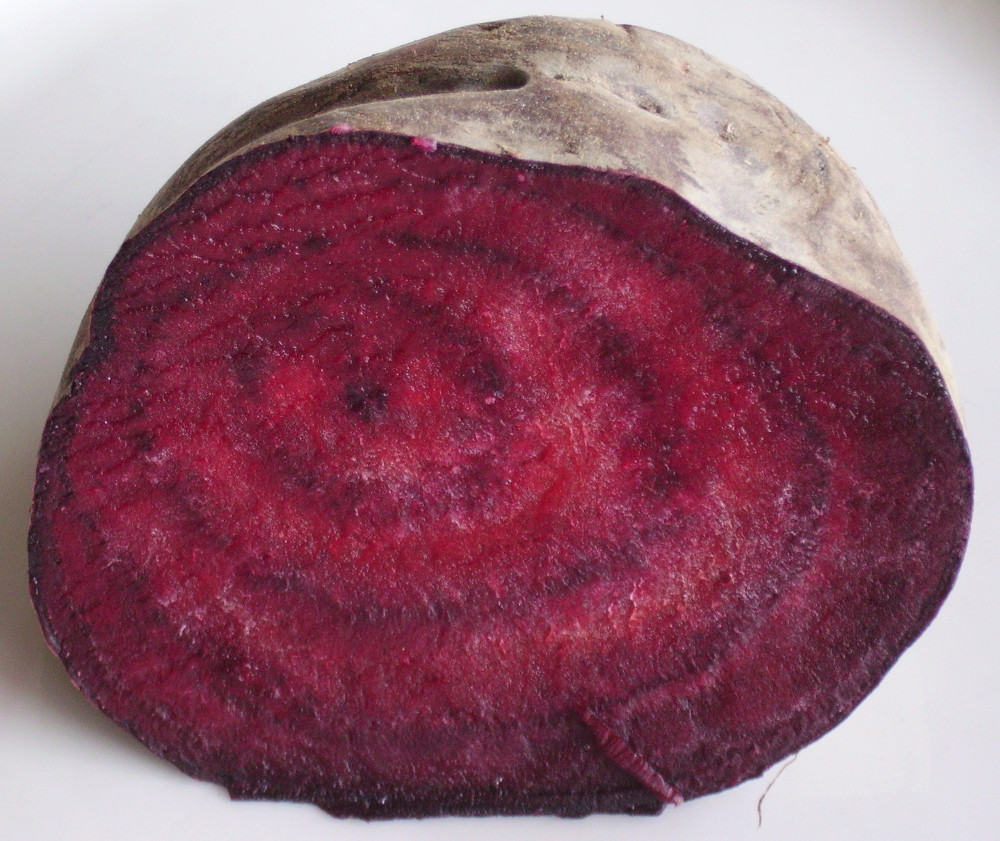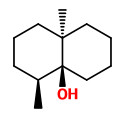Beta vulgaris L. subsp. vulgaris Conditiva Group - syn.Beta vulgaris subsp. rapacea var. conditiva; Beta vulgaris var. conditiva - Chenopodiaceae (also placed in Amaranthaceae)
beet, beetroot, Rote Beete
„Other than as a food, beets have use as a food coloring and as a medicinal plant… A large proportion of the commercial production is processed into boiled and sterilised beets or into pickles. In Eastern Europe, beet soup, such as borsch, is a popular dish. In Indian cuisine, chopped, cooked, spiced beet is a common side dish.“ https://en.wikipedia.org/wiki/Beetroot
By headspace examination of the salt-saturated juice from raw vegetable tissue, mainly 2-sec-butyl-3-methoxypyrazine, but also some 2-isobutyl-3-methoxypyrazine and 2-isopropyl-3-methoxypyrazine have been found important olfactory (green earthy vegetable-like) volatile components of beetroot.
[Murray, Keith E., and Frank B. Whitfield. „The occurrence of 3‐alkyl‐2‐methoxypyrazines in raw vegetables.“ Journal of the Science of Food and Agriculture 26.7 (1975): 973-986]
Beet extract prepared by steam distillation to evaluate the volatile components yielded a base fraction with potato-like odor and a neutral fraction with distinct earth-like odor, leading to a single compound, geosmin (known as product of soil-organisms of the order Actinomycetes).
[Geosmin, the earthy component of table beet odor., Acree, T.E., Lee, C.Y., Butts, R.M., Barnard, J., Journal of Agricultural and Food Chemistry, 24(2), 1976, 430-431]
„A unique feature of this vegetable is the high concentration of 4-methylpyridine and pyridine, which constitute about 60% of the total volatiles. Other components present at greater than 1% level include dimethyl sulfide, isovaleraldehyde, ethanol, isopentanol and furfural. The occurrence of geosmin and 2-methoxy-3-secbutylpyrazine were confirmed; the low flavor thresholds of these compounds suggest they play a role in beet flavor.“
[Parliment, T.H., Kolor M.G., and Maing I.Y., „Identification of the major volatile components of cooked beets.“ Journal of Food Science 42.6 (1977): 1592-1593]
„A selected panel was used to determine the odor threshold of geosmin [trans-1,10-dimethyl-trans-(9)decalol], an important aroma constituent of table beets, in juice made from cooked and peeled beets. The estimated threshold of 5.8 parts geosmin in 109 parts beet juice was 35 times higher than the odor threshold of geosmin in water determined by the same panel. Four samples of cooked beet juice containing different levels of geosmin were subsequently ranked according to their characteristic beet-like aroma. An increase in geosmin content was perceived as an increase in beet-like aroma up to a 5.8 ng/g concentration of geosmin. Juice made from cooked and peeled beets showed a 56-60% reduction in geosmin content in comparison with juice prepared from raw beets (with geosmin concentration below 5.8 ng/g). Therefore processing may reduce the characteristic aroma of beets.“
[Sensory evaluation of geosmin in juice made from cooked beets., Tyler, L.D., Acree, T.E., Smith, N.L., Journal of Food Science, 44(1), 1979, 79-81]
„The presence of geosmin in aseptically grown beet seedlings was confirmed by gas chromatography-mass spectrometry using authentic geosmin as the standard. During aseptic growth, the concentration of geosmin in seedlings remained constant for up to 5 months but increased at 6 months. Geosmin added to the growth medium was not absorbed by the seedlings. These studies support the conclusion that red beets are capable of endogenous synthesis of geosmin.“
[Biosynthetic origin of geosmin in red beets (Beta vulgaris L.)., Lu, G., Edwards, C.G., Fellman, J.K., Mattinson, D.S., Navazio, J., Journal of agricultural and food chemistry, 51(4), 2003, 1026-1029]
Flavor compounds determined in beetroots include mainly 4-methylpyridine (54,4%), pyridine (5.6%), dimethyl sulfide (1.5%), geosmin (0.3%) and 3-sec-butyl-2-methoxypyrazine (0.16%). Geosmin is responsible for the characteristic „earthy“ smell. Its concentration in three investigated juices were 6.78, 7.18 and 16.25 µg/l.
[Sommer, B., Antioxidative Wirkung von Roter Beete (Doctoral dissertation, Uni Wien), 2008, p.8] http://othes.univie.ac.at/926/1/2008-08-21_0400984.pdf
The most potent aroma-active compounds (highest FD factors) of canned beets were 1-octen-3-one (mushroom), 2-acetyl-1-pyrroline (popcorn), 2-isopropyl-3-methoxypyrazine (earthy), methional (cooked potato), acetic acid (vinegar), 2-sec-butyl-3-methoxypyrazine (earthy), 2-isobutyl-3-methoxypyrazine (bell pepper), isovaleric acid (cheesy), unknown (rose floral), geosmin (earthy), 4,5-epoxy-(E)-2-decenal (metallic), furaneol (caramel), p-ethyl guaiacol (clove), eugenol (clove), p-vinylguaiacol (spice), phenylacetic acid (honey), and vanilline (vanilla).
Aroma-active compounds in headspace of canned beets were methanethiol (rotten vegetable-like, sulfur), dimethyl sulfide (canned corn-like), 3-methylbutanal (dark chocolate), 2-methylbutanal (dark chocolate), 2-acetyl-1-pyrroline (popcorn), dimethyl trisulfide (garlic salt, cabbage), 2-isopropyl-3-methoxypyrazine (earthy), methional (cooked potato), 2-sec-butyl-3-methoxypyrazine (earthy), 2-isobutyl-3-methoxypyrazine (bell pepper), and geosmin (earthy).
[Richardson, Bethany. „Identification and characterization of potent odorants in selected beet root (Beta vulgaris) products.“ (2013)]
„…hedonic selection and rapid sensory evaluation showed that cultivars with a wide range of geosmin concentration could be accepted by consumers and, indeed, that geosmin concentration is neither the trait around which hedonic liking of beet is organized nor an indicator of perceived earthy flavor.“
[Hanson, Solveig J., Julie C. Dawson, and Irwin L. Goldman. „Participatory plant breeding reveals that geosmin concentration is not the central determinant of hedonic liking in table beet.“ Euphytica 218.2 (2022): 14]

beetroot, Author: Garitzko Wikimedia Commons
